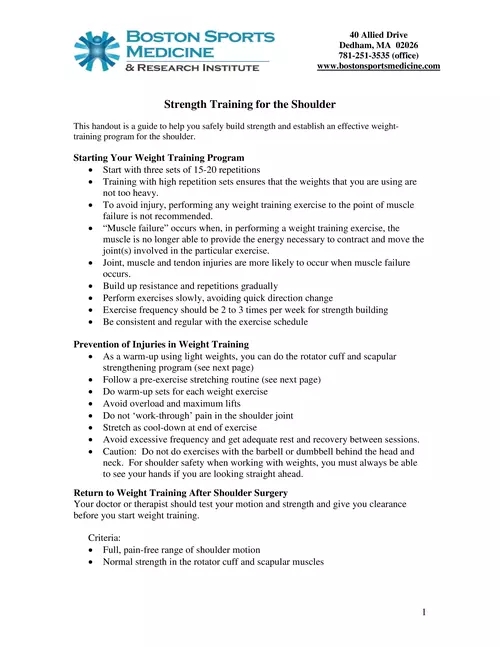
Weight Training for the Shoulder - Boston Sports Medicine
2. Triceps machine or free weight triceps exercise. 3. Chest press machine or bench press. 4. Seated row machine or bent over dumbbell rows.
adsPart of the document
Strength Training for the Shoulder
This handout is a guide to help you safely build strength and establish an effective weight-
training program for the shoulder.
Starting Your Weight Training Program
Start with three sets of 15-20 repetitions
Training with high repetition sets ensures that the weights that you are using are
not too heavy.
To avoid injury, performing any weight training exercise to the point of muscle
failure is not recommended.
"Muscle failure" occurs when, in performing a weight training exercise, the
muscle is no longer able to provide the energy necessary to contract and move the
joint(s) involved in the particular exercise.
Joint, muscle and tendon injuries are more likely to occur when muscle failure
occurs.
Build up resistance and repetitions gradually
Perform exercises slowly, avoiding quick direction change
Exercise frequency should be 2 to 3 times per week for strength building
Be consistent and regular with the exercise schedule
Prevention of Injuries in Weight Training
As a warm-up using light weights, you can do the rotator cuff and scapular
strengthening program (see next page)
Follow a pre-exercise stretching routine (see next page)
Do warm-up sets for each weight exercise
Avoid overload and maximum lifts
Do not 'work-through' pain in the shoulder joint
Stretch as cool-down at end of exercise
Avoid excessive frequency and get adequate rest and recovery between sessions.
Caution: Do not do exercises with the barbell or dumbbell behind the head and neck. For shoulder safety when working with weights, you must always be able
to see your hands if you are looking straight ahead.
Return to Weight Training After Shoulder Surgery
Your doctor or therapist should test your motion and strength and give you clearance
before you start weight training.
Criteria:
Full, pain-free range of shoulder motion
Normal strength in the rotator cuff and scapular muscles
Exercises and rehabilitation
Dr. Gill or your physical therapist will instruct the appropriate stretching and strengthening
exercises. It is recommended that you do not begin shoulder exercises without proper instruction
and exercise selection based upon your particular set of shoulder circumstances.
Shoulder Stretching Program
The stretching exercises are intended
to improve or maintain normal flexibility and range
of motion of the shoulder. 1 or 2 of each stretch should be done before weight training
(after warming up) and 3 to 5 of each stretch should be done after finishing your workout.
Each stretch should be
held for 10 to 15 seconds in a static fashion without bouncing or
oscillation. Stretching should be done gently, without pain.
Shoulder Strengthening Program
Theraband Strengthening for the shoulder
These resistance exercises should be done very slowly in
both
directions. The goal is to achieve a
maximum amount of strengthening while listening to your end
-point of pain. Work within a pain
free range of motion at all times and do the exercises very slowly. The slower the motion, the
better the muscle contraction is throughout the range of movement.
Shoulder theraband exercises can be found online on our website.
Rotator Cuff and Scapular Strengthening Pro
gram
The
rotator cuff and scapular exercises are intended to isolate the essential muscles of the
shoulder that provide strength to the rotator cuff and control the scapula (shoulder blade). Each
exercise should be done for one set of 15 repetitions prior to a weight training workout or 2-3
times a week for good shoulder strength and muscle balance. Weights used with these exercises
can be built up gradually in increments of no more than 1 pound per week, with a safe limit of 5
lb.
Rotator cuff and scapu
lar exercises (Shoulder 12 Strengthening Program) can be found online on
our website.
Weight Training Program
The following upper body and shoulder strength program is usually safe and provides a
good basic foundation of upper body and shoulder strength
when combined with the
basic shoulder strength and stretch program outlined earlier. The strength program can
be followed 2 to 3 times a week. 3 sets of 10 to 15 repetitions can be done for each
exercise. You can follow the principles of PRE and RM as
outlined in the next section to
know when to increase weights in programs where the goal is to increase strength.


